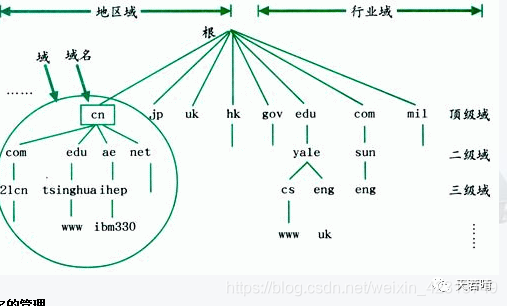本文共 2454 字,大约阅读时间需要 8 分钟。
文章目录
1. DNS是什么
DNS(DomainName System)域名系统,在TCP/IP网络中有非常重要的地位,能够提供域名与IP地址的解析服务。
DNS是一个分布式数据库,命名系统采用层次的逻辑结构,如同一棵倒置的树,这个逻辑的树形结构称为域名空间,由于DNS划分了域名空间,所以各机构可以使用自己的域名空间创建DNS信息。
注:DNS域名空间中,树的最大深度不得超过127层,树中每个节点最长可以存储63个字符。
2. 域和域名
- 域:DNS树的每个节点代表一个域,通过这些节点,对整个域名空间进行划分,成为一个层次结构。域名空间的每个域的名字,通过域名进行表示。
- 域名:通常由一个完全合格域名(FQDN)标识。FQDN能准确表示出其相对于DNS域树根的位置,也就是节点到DNS树根的完整表述方式,从节点到树根采用反向书写,并将每个节点用“.”分隔,对于DNS域google来说,其完全正式域名(FQDN)为google.com。
说明:FQDN:(FullyQualified Domain Name)全限定域名:同时带有主机名和域名的名称。(通过符号“.”)
例如:google为com域的子域,其表示方法为google.com,而www为google域中的子域,可以使用www.google.com表示。 注意:通常,FQDN有严格的命名限制,长度不能超过256字节,只允许使用字符a-z,0-9,A-Z,域名不区分大小写。以www.baidu.com为例 根域名是com、顶级域名是baidu.com、主域名是www.baidu.com
由最顶层到下层,可以分成:根域、顶级域、二级域、子域。

3. 主域名服务器与辅助域名服务器的关系
- 当区的辅助服务器启动时,它与该区的主控服务器进行连接并启动一次区传输,区辅助服务器定期与区主控服务器通信,查看区数据是否改变。如果改变了,它就启动一次数据更新传输。
- 每个区必须有主服务器,另外每个区至少要有一台辅助服务器,否则如果该区的主服务器崩溃了,就无法解析该区的名称。
辅助服务器的优点:
(1) 容错能力 配置辅助服务器后,在该区主服务器崩溃的情况下,客户机仍能解析该区的名称。一般把区的主服务器和区的辅助服务器安装在不同子网上,这样如果到一个子网的连接中断,DNS客户机还能直接查询另一个子网上的名称服务器。(2) 减少广域链路的通信量
如果某个区在远程有大量客户机,用户就可以在远程添加该区的辅助服务器,并把远程的客户机 配置成先查询这些服务器,这样就能防止远程客户机通过慢速链路通信来进行DNS查询。(3) 减轻主服务器的负载
辅助服务器能回答该区的查询,从而减少该区主服务器必须回答的查询数。4. DNS服务器与缓存
(1) DNS服务器
- 运行DNS服务器程序的计算机,储存DNS数据库信息。DNS服务器会尝试解析客户机的查询请求。
- 在解答查询时,如果DNS服务器能提供所请求的信息,就直接回应解析结果,如果该DNS服务器没有相应的域名信息,则为客户机提供另一个能帮助解析查询的服务器地址。
- 如果以上两种方法均失败,则回应客户机没有所请求的信息或请求的信息不存在。
(2) DNS缓存
- DNS服务器在解析客户机请求时,如果本地没有该DNS信息,则可以会询问其他DNS服务器,当其他域名服务器返回查询结果时,该DNS服务器会将结果记录在本地的缓存中,成为DNS缓存。
- 当下一次客户机提交相同请求时,DNS服务器能够直接使用缓存中的DNS信息进行解析。
5. DNS工作原理
- DNS 查询以各种不同的方式进行解析。客户机有时也可通过使用从以前查询获得的缓存信息就地应答查询。DNS 服务器可使用其自身的资源记录信息缓存来应答查询,也可代表请求客户机来查询或联系其他 DNS 服务器,以完全解析该名称,并随后将应答返回至客户机。这个过程称为递归查询。
- 另外,客户机自己也可尝试联系其他的 DNS 服务器来解析名称。如果客户机这么做,它会使用基于服务器应答的独立和附加的查询,该过程称作迭代,即DNS服务器之间的交互查询就是迭代查询。
- DNS有两种查询方式:递归查询和迭代查询

6. 正向解析和反向解析
正向解析:正向解析是指域名到IP地址的解析过程。
 反向解析:反向解析是从IP地址到域名的解析过程。反向解析的作用为服务器的身份验证。 例:http://dns.aizhan.com/
反向解析:反向解析是从IP地址到域名的解析过程。反向解析的作用为服务器的身份验证。 例:http://dns.aizhan.com/ 7. DNS资源记录类别
1)SOA资源记录
每个区在区的开始处都包含了一个起始授权记录(Startof Authority Record),简称SOA记录。SOA定义了域的全局参数,进行整个域的管理设置。一个区域文件只允许存在唯一的SOA记录。
2)NS资源记录
NS(NameServer)记录是域名服务器记录,用来指定该域名由哪个DNS服务器来进行解析。每个区在区根处至少包含一个NS记录。3)A资源记录
地址(A)资源记录把FQDN映射到IP地址。因为有此记录,所以DNS服务器能解析FQDN域名对应的IP地址。4)PTR资源记录
相对于A资源记录,指针(PTR)记录把IP地址映射到FQDN。用于反向查询,通过IP地址,找到域名。5)CNAME资源记录
别名记录(CNAME)资源记录创建特定FQDN的别名。用户可以使用CNAME记录来隐藏用户网络的实现细节,使连接的客户机无法知道真正的域名。例:ping百度时,解析到了百度的别名服务器。百度有个cname=www.a.shifen.com.的别名
6)MX资源记录
邮件交换(MX)资源记录,为DNS域名指定邮件交换服务器。邮件交换服务器是为DNS域名处理或转发邮件的主机。处理邮件指把邮件投递到目的地或转交另一不同类型的邮件传送者。转发邮件指把邮件发送到最终目的服务器,用简单邮件传输协议SMTP把邮件发送给离最终目的地最近的邮件交换服务器,或使邮件经过一定时间的排队。

转载地址:http://yramz.baihongyu.com/